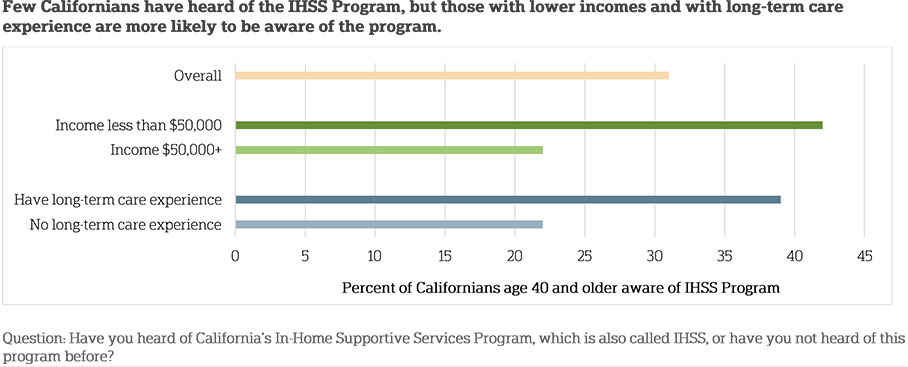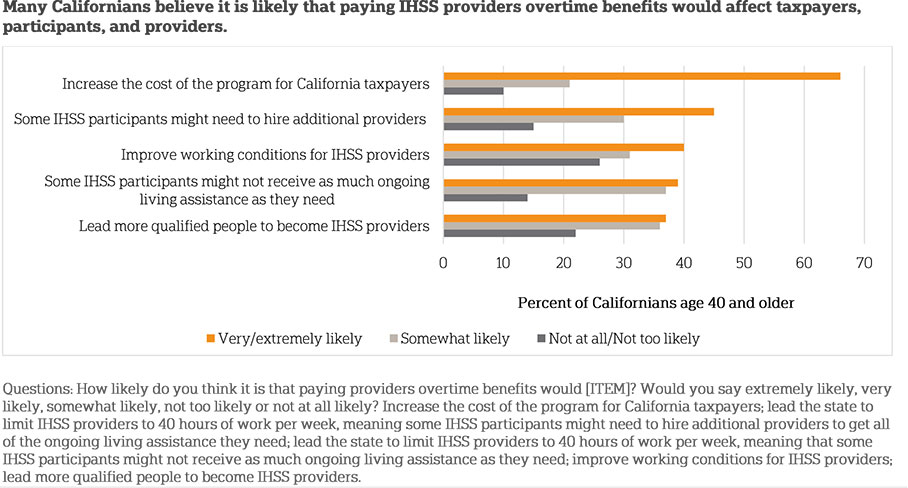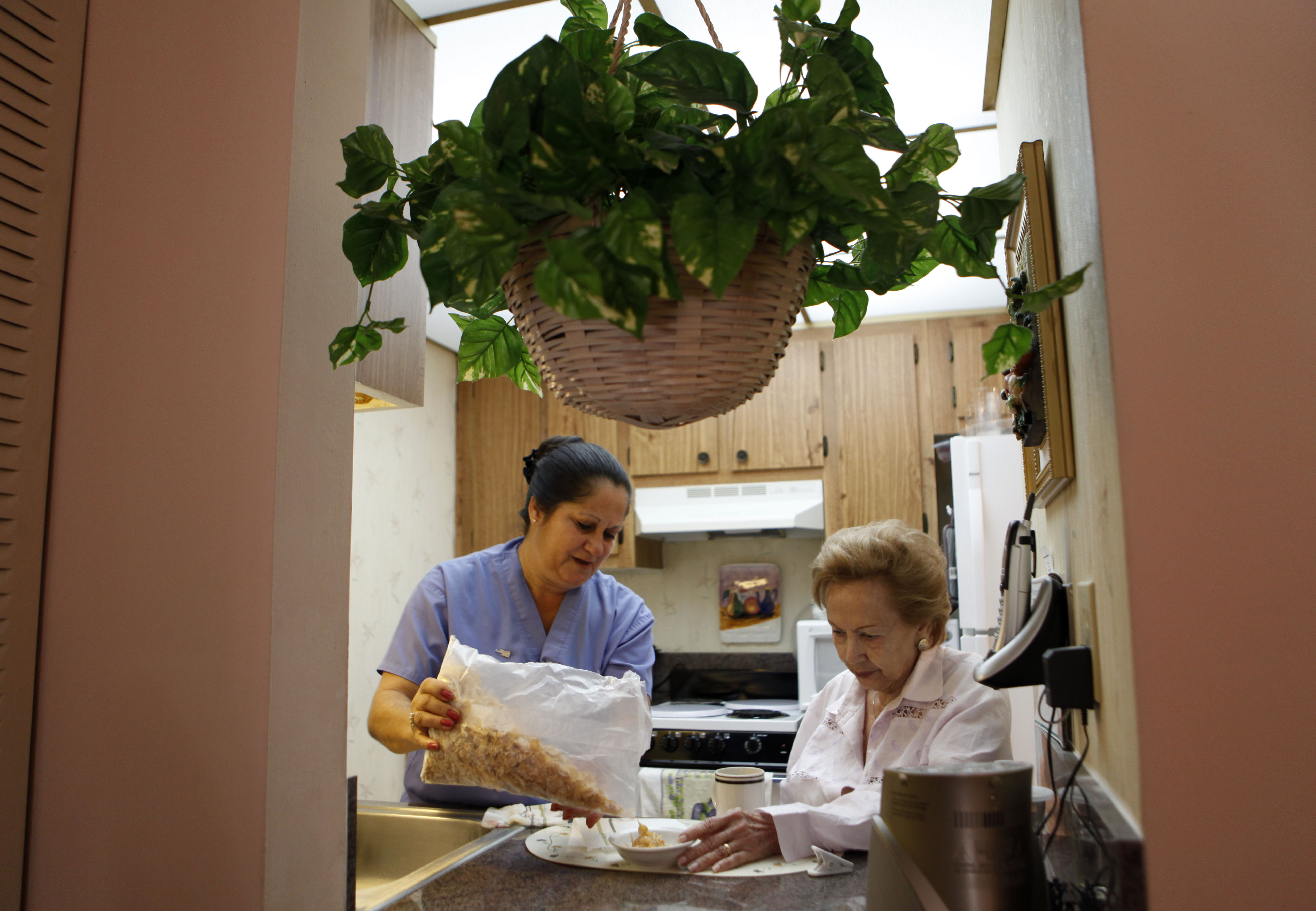
FILE - In this Sept. 3, 2010 file photo, United Home Care Services home health aide Maria Fernandez, left, pours cereal for Herminia Vega, 83, right, as she performs household chores for Vega and her husband, in Miami. On average, nearly 70 percent of people who turn 65 years-old will eventually need some form of long-term care, according to the U.S. Department of Health & Human Services. (AP Photo/Lynne Sladky)
By 2030, nearly 20 percent of California’s population will be 65 years or older, and the vast majority of these seniors will need long-term care services at some point.1 The state continues to address this population’s needs through the implementation of a range of policies and programs. The Associated Press-NORC Center for Public Affairs Research has been tracking older Californians’ opinions and experiences with long-term care in order to better understand where the public is on the issue.2
The AP-NORC Center’s 2015 survey—the third iteration of this study series funded by The SCAN Foundation— continues to show that while a large share of Californians age 40 and older say they expect to need long-term care in the future, many have done little or no planning for their care needs and lack knowledge and confidence on the financial aspects of long-term care.
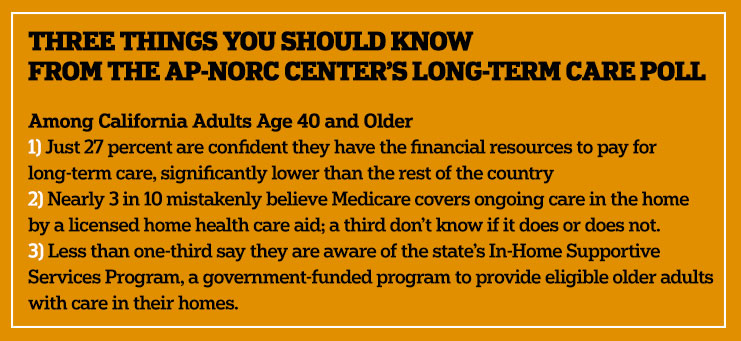
The 2015 study also provides an in-depth look at public opinion on key long-term care policy issues including how caregivers are trained and paid under the In-Home Supportive Services (IHSS) Program for eligible recipients of long-term care services. Few are aware of this government-funded program in California that helps eligible older adults receive services in their homes and many have mixed feelings about changes to the IHSS Program proposed by different stakeholders.
This year, the AP-NORC Center conducted 1,735 interviews with a nationally representative sample of adults age 40 and older. The study includes an oversample of 460 Californians and 419 Hispanics nationwide age 40 and older. While for the most part the trends in California remain relatively stable, new findings are presented below:
- Among Californians age 40 and older, awareness of the IHSS Program is low. Less than a third say they are aware of the program, though awareness is higher among those with lower household incomes.
- Californians age 40 and older have mixed feelings about changes to the IHSS Program proposed by different stakeholders. Two-thirds favor a requirement for formal training for providers, but they anticipate both positive and negative consequences if IHSS includes a provision for overtime pay to caregivers.
- Californians age 40 and older are less likely than those in the rest of the country to hold misperceptions about the role of private health insurance and Medicare in paying for long-term care services.
- Californians’ confidence in their ability to pay for their own long-term care needs is lower than that seen in the rest of the United States. Californians with lower incomes, those age 40-54, and those with a high school education or less are especially lacking in confidence.
- A majority of Californians age 40 and older expect to one day need long-term care, but 56 percent still say they have done only a little planning or no planning at all.
Additional information, including the survey’s complete topline findings, can be found on the AP-NORC Center’s long-term care project website at www.longtermcarepoll.org.
Most Californians Are Unfamiliar With The In-Home Supportive Services Program, With Differences In Awareness Based On Income And Experience With Long-Term Care.ꜛ
The In-Home Supportive Services (IHSS) Program is a government-funded program that pays for ongoing living assistance3 for Medi-Cal eligible adults. Through the IHSS Program, adults age 65 and older and people with disabilities can remain in their homes to receive care rather than moving to a nursing home or other care facility. IHSS participants are permitted to select their own care provider, and the provider can be a family member or friend of the participant.4
The majority of Californians age 40 and older report they are unaware of the IHSS Program, with fewer than 1 in 3 saying they have heard of it. Personal experience with ongoing living assistance, either as a recipient or provider, is related to hearing about IHSS. Thirty-nine percent of those with personal experience with ongoing living assistance report having heard of IHSS compared with 22 percent of those without such experience. No significant differences in awareness emerged based on respondents’ main type of insurance, whether that insurance is Medicaid (32 percent aware), Medicare (28 percent aware), or private insurance (28 percent aware). Additionally, awareness among those without any insurance is not significantly different than those with insurance (27 percent vs. 31 percent).
There are significant differences in awareness based on income. Californians age 40 and older with lower household incomes are also about twice as likely to report having heard about IHSS as those with higher household incomes. Forty-two percent of those with household incomes under $50,000 a year say they have heard of IHSS compared with 22 percent of those with household incomes of $50,000 a year or more.
A Majority Supports Formal Training For Caregivers, And Many Believe Overtime Pay For Providers Would Impact Participants, Providers, And Taxpayers. ꜛ
Under the current IHSS Program, providers are not required to have any formal training on providing ongoing living assistance.5 After being read a brief description of the IHSS program,6 a majority of Californians age 40 and older supports a requirement for state-funded formal training for caregivers who provide ongoing living assistance under the program. Sixty-five percent of Californians in this age group say they somewhat or strongly favor such formal training for caregivers, and only 18 percent oppose a requirement for training. Whites are less likely to favor formal training for caregivers (58 percent) than either Hispanics (83 percent) or blacks (80 percent).
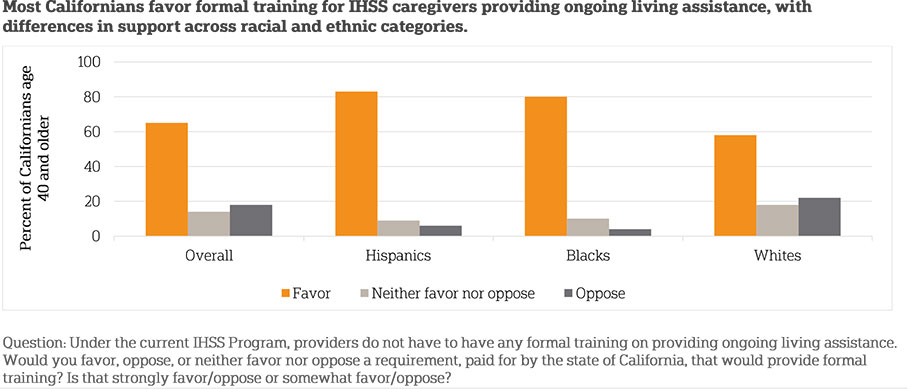
Currently, IHSS providers are not eligible to receive overtime pay when they provide care for more than 40 hours in a given week.7 Reflecting similar conversations at the federal level, there have been discussions in California amongst long-term care stakeholders about a policy change that would allow for overtime pay for providers when they spend more than 40 hours a week providing ongoing living assistance services.8 When it comes to the possible effects of paying providers overtime benefits, many Californians age 40 and older think taxpayers, participants, and providers would all feel the impact of such a change in the program.
Two in 3 Californians age 40 and older say it is very or extremely likely that paying overtime benefits would increase the cost of the program for California taxpayers. Income is associated with beliefs about the effects on taxpayers of providing overtime pay for caregivers. Seventy-four percent of those with household incomes of $50,000 a year or more report that providing overtime benefits would raise costs for state taxpayers compared with 61 percent of those with annual household incomes of under $50,000.
About 4 in 10 Californians say providing overtime pay would lead to negative effects for participants because the state would then set limits on the number of hours IHSS providers can work to avoid the extra costs of overtime pay. In particular, 45 percent say limiting hours due to overtime pay would mean some participants would have to hire additional providers, and 39 percent say that some participants might not receive as much assistance as they need due to such hour limits.
As for the effect on providers, 37 percent say overtime pay is likely to lead more qualified people to become providers, and 40 percent report it is likely to improve working conditions for providers. Age is related to opinions toward the effect of overtime pay on improving working conditions for providers. Forty-three percent of those 40-64 years old say paying overtime benefits is very or extremely likely to improve working conditions for providers compared with 32 percent of those age 65 and older.
When It Comes To Financing Long-Term Care, Californians Hold Fewer Misperceptions About The Role Of Private Insurance And Medicare But Many Are Unsure What Insurance Does Or Does Not Cover.ꜛ
Private health insurance plans in the United States do not provide widespread coverage for many of the ongoing living assistance services older adults may need as they age. The typical private health insurance plan in the United States does not cover ongoing care in a nursing home, nor will it cover ongoing care at home by a licensed home health care aide. These plans will cover medical equipment such as wheelchairs and other assistive devices, but only in certain circumstances.
Californians age 40 and older are less likely than adults age 40 and older in the rest of the United States to incorrectly believe that a typical health insurance plan in the United States will cover ongoing care in a nursing home (14 percent vs. 19 percent). Additionally, 1 in 4 adults both in California and outside of California mistakenly believe that ongoing care received in the home is covered by the typical health insurance plan. Similar numbers of adults age 40 and older in California (46 percent) and outside of California (47 percent) believe medical equipment is covered by private health insurance. Both in California and in the rest of the country, about 2 in 10 say they do not know if a typical health insurance plan covers any of these three long-term care needs.
Similar to private health insurance plans, Medicare does not cover ongoing care in a nursing home nor ongoing care at home by a licensed home health care aide, but it will cover assistive medical equipment when deemed by a physician as medically necessary. Californians age 40 and older are less likely than adults age 40 and older in the rest of the United States to say they believe each of these three services are covered by Medicare.
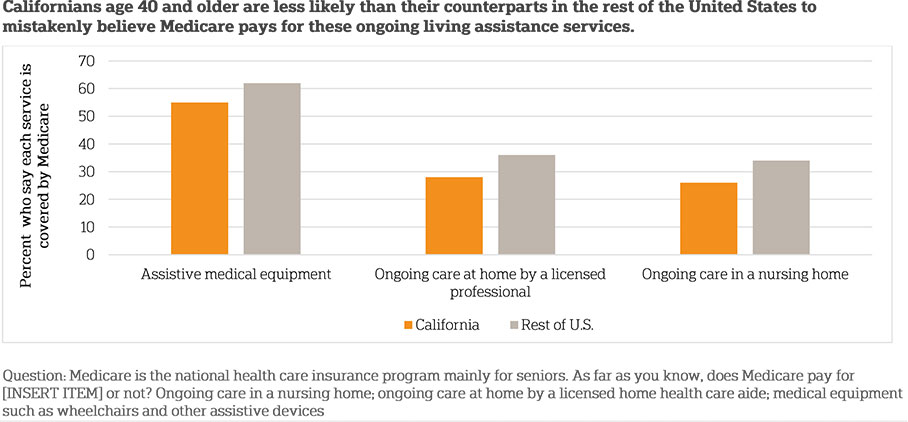
The tendency for Californians to misunderstand the long-term care services that Medicare provides has fluctuated over the past year. In 2014, 37 percent of Californians age 40 and older mistakenly believed that Medicare covers ongoing, in-home care by a licensed health care aide. Today, just 28 percent of Californians believe this, a nearly 10 point decline. Likewise, the percent of Californians age 40 and older who mistakenly believed that Medicare covers assistive medical equipment and devices has declined from 74 percent in 2014 to 55 percent in 2015.
Only the perception of Medicare coverage of ongoing care in a nursing home remains statistically unchanged since 2014; 26 percent of Californians age 40 and older report correctly that this type of service is not covered by Medicare.
However, there have not been significant changes since 2014 in the number of Californians age 40 and older who correctly say that these services are not covered by Medicare. In fact, there are fewer who correctly say Medicare does not cover ongoing care in a nursing home since 2013. The shift over time is instead toward more Californians expressing that they are unsure of what Medicare does or does not cover when it comes to ongoing living assistance. The number of Californians saying they do not know if Medicare covers these three long-term care needs has increased for each item since 2013. For ongoing care in a nursing home, the number of people saying they do not know has increased from 18 percent to 33 percent. For ongoing care at home by a licensed home health care aide, the number has increased from 22 percent to 33 percent. And for medical equipment such as wheelchairs and other assistive devices, it has increased from 11 percent to 25 percent.
Additionally, Californians are more likely than those in the rest of the United States to say they do not know if Medicare covers ongoing care in a nursing home (33 percent to 27 percent), at home care by a licensed home health care aid (33 percent to 27 percent), and medical equipment such as wheelchairs and other assistive devices (25 percent to 18 percent).
Medicaid, a government-funded health care coverage program for people with low-incomes and disabilities, is the largest payer of ongoing living assistance benefits in the United States.9 Similar to adults living in the rest of the United States, few Californians anticipate needing this type of assistance; just 38 percent of Californians age 40 and older say they anticipate needing Medicaid to help pay for their ongoing living assistance expenses as they age. A plurality, 48 percent, say they will not need this type of assistance, and 14 percent say they do not know if it will be needed or not. Beliefs about the need for Medicaid services remain unchanged from a year ago.
Sharp divisions based on economic status emerge in California residents’ anticipation of needing Medicaid benefits. Californians with a high school education or less are over twice as likely as those with at least some college experience to say they anticipate needing Medicaid to help pay for ongoing living assistance expenses (56 percent vs. 25 percent). Lower-income adults are more likely to indicate that they will need to rely on Medicaid to cover long-term care expenses (54 percent vs. 22 percent).
Californians’ Confidence In Their Ability To Pay For Long-Term Care Remains Low And Below The National Average.ꜛ
While adults nationwide lack confidence in their ability to pay for their own long-term care needs as they age, confidence in this ability is even lower among Californians. Twenty-seven percent of Californians age 40 and older say they are confident they will have the financial resources to pay for any care they may need as they get older, compared to 33 percent of adults age 40 and older in the rest of the United States. These rates have not changed significantly since 2014.
Confidence in having the financial resources to pay for long-term care services varies significantly across several demographic groups. Californians with incomes of $50,000 or more are three times as likely as those with incomes of less than $50,000 to say they are confident they will be able to afford long-term care services (40 percent vs. 13 percent). Adults age 65 and older are more than twice as likely as adults age 40-54 to express confidence in their ability to pay for living assistance as they age (39 percent vs. 18 percent). Californians with a high school education or less are less likely than those with at least some college experience to say they are confident they will have the financial resources to pay for long-term care (16 percent vs. 34 percent).
A Majority Of Californians Think They Will Likely Need Ongoing Living Assistance Someday, And While They Are Increasingly Likely To Plan For That Assistance, More Than Half Have Planned Very Little.ꜛ
Over half of Californians age 40 and older who are not currently receiving ongoing living assistance say it is at least somewhat likely they will need such care someday (58 percent). This includes 21 percent who say it is very or extremely likely that they will need ongoing living assistance and 37 percent who say it is somewhat likely. Thirty-eight percent say they are not too likely or not likely at all to need ongoing living assistance. No significant differences emerge between demographic groups. Like the United States as a whole, fewer Californians age 40 and older expect they will need ongoing living assistance in the future compared to two years ago. The percentage of Californians age 40 and older who say it is at least somewhat likely they will need care has dropped 10 points since 2013.
Despite large shares of the state’s 40 and older population saying they will eventually need ongoing living assistance, 56 percent of these Californians say they have done little or no planning for their own ongoing living assistance needs. Twenty percent say they have done a great deal or quite a bit of planning, and 24 percent say they have done a moderate amount of planning. No significant differences between demographic groups are observed. These rates are also not significantly different than the rates for the rest of the country, but they do represent a decline in the number of Californians who say they have done little or no planning compared to 2014 when 66 percent of adults age 40 and older in the state reported this low level of planning. Looking at one specific planning behavior, 31 percent of Californians age 40 and older now say they have looked for information about aging issues and ongoing living assistance, a 10 point increase since 2014. There were, however, no significant increases in any other planning behaviors asked about.
A majority (51 percent) of Californians age 40 and older who are not currently providing care say it is at least somewhat likely that a family member or close friend will need ongoing living assistance in the next five years. This includes 28 percent who say it is extremely or very likely they will need care and 24 percent who say it is somewhat likely, in addition to 45 percent who say it is not too likely or not likely at all. There are no significant differences between demographic groups, and the overall California rates are not significantly different than the rates for the rest of the country. But, they represent a decline in the number of people who say it is at least somewhat likely that a family member or friend will need care compared to 2014 (61 percent).
Continuing Trends And Other Comparisons Between California And The Rest Of The United States.ꜛ
Some of the attitudes and experiences reported by Californians age 40 and older reflect those of the rest of the country, and they oftentimes have not changed significantly from what they reported in 2014.
- Half of Californians age 40 and older (52 percent) say they have some experience with long-term care, either providing, receiving, or employing someone to provide care. This rate is nearly identical to that of the rest of the United States and is not significantly different from the findings of the 2014 survey.
- Over a third (37 percent) of Californians think that they personally will be the ones responsible for providing care to their family member or friend in need. This is not significantly different from the rest of the United States or the proportion in California in 2014.
- Those who say it is at least somewhat likely that they will provide care do not say they are very prepared to do so. Just 24 percent of Californians age 40 and older say they are very or extremely prepared to provide care. This is not significantly different from 2014 or the rest of the United States.
- Californians age 40 and older do not show any changes in their level of concern about changes in their personal situations, like leaving debts to their family or losing their memory or other mental abilities compared to 2014, and they are not significantly different from the rates of concern for the rest of the United States.
- A third of Californians age 40 and older have set aside money to pay for ongoing living assistance, no different than the rest of the country or the California rate in 2014.
- Thirty-one percent of Californians age 40 and older say they have looked up information on aging issues and ongoing living assistance, which is significantly higher than the rest of the country (24 percent) and the California rate in 2014 (21 percent), though it is similar to the California rate in 2013 (30 percent).
- In a new question asked in 2015, 27 percent say they have looked up information on long-term care insurance, which is not significantly different than the rest of the country (28 percent).
- Thirty-nine percent of Californians age 40 and older say they have discussed their preferences for the kinds of ongoing living assistance they do or do not want with their families. This is not significantly different than the rest of the country (43 percent) or the rate in California in 2014 (34 percent).
- Fifty-nine percent of Californians age 40 and older say they favor a government-administered long-term care insurance program, similar to Medicare. This has not changed significantly from 2014.
- Seventy percent of Californians age 40 and older say they favor tax breaks for saving for ongoing living expenses, which is statistically equivalent to the 79 percent who said the same in 2014.
- A majority of Californians age 40 and older favors tax breaks for consumers to purchase long-term care insurance. Seven in 10 favored this policy in 2014 and 2015.
- Overall, 72 percent of Californians age 40 and older favor an employer-sponsored long-term care insurance program, about the same as the 71 percent who said so in 2014.
- An individual requirement to purchase long-term care insurance is still the least-favored policy solution with just 32 percent of Californians age 40 and older favoring it, no different than the 36 percent who said the same in 2014.
About The Studyꜛ
Study Methodology
This survey, funded by The SCAN Foundation, was conducted by The Associated Press-NORC Center for Public Affairs Research between the dates of April 7 and May 15, 2015. Staff from NORC at the University of Chicago, The Associated Press, and The SCAN Foundation collaborated on all aspects of the study.
This survey of the 50 states and the District of Columbia was conducted via telephone with 1,735 adults age 40 and older. In households with more than one adult 40 and older, we used a process that randomly selected which eligible adult would be interviewed. The sample included 1,130 respondents on landlines and 605 respondents on cell phones. The sample also included an oversample of Californians 40 years and older. The sample includes 460 residents of California age 40 and older. In addition, the sample included an oversample of Hispanics 40 years and older. The sample includes 419 Hispanics age 40 and older.
Respondents on landline phones were selected randomly within households. For households with two eligible adults age 40 or older, one respondent was selected randomly by the CATI system. For households with three adults or more age 40 or older, the respondent who most recently celebrated a birthday at the time of the call was selected. If the selected respondent was not available at the time of the call, interviewers were trained to set up a time to call back to speak with that respondent. To avoid an imbalance of older respondents on landline telephones, an additional screening criterion was added after we had surpassed the population proportion of adults age 65 and older (using ACS10 and NHIS11estimates), such that landline households where all adults are age 65 and older were ineligible after this point. We continued to interview some adults age 65 and older after this point, on cell phones and in households reached via landline where at least one adult was under the age of 65. Cell phone respondents were offered a monetary incentive of $5 for participating, as compensation for telephone usage charges. Interviews were conducted in both English and Spanish, depending on respondent preference. All interviews were completed by professional interviewers who were carefully trained on the specific survey for this study.
The random digit dial sample, including the California oversample, was provided by a third-party vendor, Marketing Systems Group. The final response rate for the overall sample was 11 percent, based on the American Association of Public Opinion Research Response Rate 3 Method. Additionally, the final response rate for the California sample was 11 percent, and the final response rate for the Hispanic sample was 3 percent.
The sampling frame utilizes the standard dual telephone frames (landline and cell), with an oversample of numbers from the state of California, and a supplemental sample of both landline and cell numbers targeting households with Hispanic adults. The targeted sample was provided by Scientific Telephone Samples and was pulled from a number of different commercial consumer databases and demographic data. Sampling weights were calculated to adjust for sample design aspects (such as unequal probabilities of within household selection) and for nonresponse bias arising from differential response rates across various demographic groups. Poststratification variables included age, sex, race, region, education, and landline/cell phone use. The weighted data, which thus reflect the U.S. population, were used for all analyses. The overall margin of sampling error was +/- 3.2 percentage points, adjusted for design effect resulting from the complex sample design. The California sample’s margin of sampling error was +/- 5.4 percentage points, and the Hispanic sample’s margin of sampling was +/- 6.0 percentage points, both also adjusted for design effect resulting from the complex sample design.
All analyses were conducted using STATA (version 13), which allows for adjustment of standard errors for complex sample designs. All differences reported between subgroups of the U.S. population are at the 95 percent level of statistical significance, meaning that there is only a 5 percent (or less) probability that the observed differences could be attributed to chance variation in sampling. Additionally, bivariate differences between subgroups are only reported when they also remain robust in a multivariate model controlling for other demographic, political, and socioeconomic covariates. A comprehensive listing of all study questions, complete with tabulations of top-level results for each question, is available on The AP-NORC Center for Public Affairs Research long-term care website: www.longtermcarepoll.org.
Contributing Researchers
From NORC at the University of Chicago
Jennifer Benz
Dan Malato
Becky Reimer
Trevor Tompson
Emily Alvarez
David Sterrett
Ivana Cvarkovic
Marjorie Connelly
Elizabeth Kantor
Wei Zeng
Jie Zhao
From The Associated Press
Emily Swanson
About the Associated Press-NORC Center for Public Affairs Research
The AP-NORC Center for Public Affairs Research taps into the power of social science research and the highest-quality journalism to bring key information to people across the nation and throughout the world.
- The Associated Press (AP) is the world’s essential news organization, bringing fast, unbiased news to all media platforms and formats.
- NORC at the University of Chicago is one of the oldest and most respected, independent research institutions in the world.
The two organizations have established The AP-NORC Center for Public Affairs Research to conduct, analyze, and distribute social science research in the public interest on newsworthy topics, and to use the power of journalism to tell the stories that research reveals.
The founding principles of The AP-NORC Center include a mandate to carefully preserve and protect the scientific integrity and objectivity of NORC and the journalistic independence of AP. All work conducted by the Center conforms to the highest levels of scientific integrity to prevent any real or perceived bias in the research. All of the work of the Center is subject to review by its advisory committee to help ensure it meets these standards. The Center will publicize the results of all studies and make all datasets and study documentation available to scholars and the public.
The complete topline data are available at www.longtermcarepoll.org.
Footnotesꜛ
1. State of California, Department of Finance. 2014. Report P-1 (Age): State and County Population Projections by Major Age Groups, 2010-2060ꜛ
2. AP-NORC Center for Public Affairs Research. 2014. Long-Term Care in California: Issue Brief. https://www.longtermcarepoll.org/Pages/Polls/Long-Term-Care-in-California-Issue-Brief.aspxꜛ
3. Ongoing living assistance was defined for respondents as follows: “assistance can be help with things like keeping house, cooking, bathing, getting dressed, getting around, paying bills, remembering to take medicine, or just having someone check in to see that everything is okay. This help can happen at your own home, in a family member’s home, in a nursing home, or in a senior community. And, it can be provided by a family member, a friend, a volunteer, or a health care professional.”ꜛ
4. California Department of Social Services. 2015. Overview of the IHSS Program. http://www.cdss.ca.gov/agedblinddisabled/res/FactSheets/IHSS_Program_Overview_BlackWhite.pdfꜛ
5. Barrett, Gloria J., and Mary L. Blackburn. 2010. “The Need for Caregiver Training is Increasing as California Ages.” California Agriculture 64(4): 201-207.ꜛ
6. Respondents were read the following description: “The In-Home Supportive Services Program, called IHSS for short, is a program in California available to Medi-Cal eligible adults ages 65 and older and people with disabilities. It pays for ongoing living assistance so participants can receive services in their own home rather than moving to a nursing home or other care facility. IHSS participants are responsible for hiring the person who will provide their ongoing living assistance in their own home. Providers can be family members or friends of the participant. Under the current IHSS program, providers do not have to have any formal training on providing ongoing living assistance.”ꜛ
7. California Department of Social Services. 2015. State Halts Implementation of Overtime for In-Home Supportive Services. http://www.cdss.ca.gov/cdssweb/entres/pdf/PressRelease/Judges_Ruling_Vacates.pdfꜛ
8. The SCAN Foundation. 2015. Summary of the Governor’s May Revision of the 2015-16 Budget: Impact on California’s Older Adults and People with Disabilities. http://www.thescanfoundation.org/summary-governors-may-revision-2015-16-budget-impact-californias-older-adults-and-peopleꜛ
9. Kaiser Commission on Medicaid and the Uninsured. 2015. Medicaid and Long-Term Services and Supports: A Primer. http://kff.org/medicaid/report/medicaid-and-long-term-services-and-supports-a-primer/ꜛ
10. United States Census Bureau. 2014. American Community Survey (ACS). http://www.census.gov/acs/www/data_documentation/2013_release/ꜛ
11. Centers for Disease Control and Prevention. 2014. National Health Interview Survey (NHIS). http://www.cdc.gov/nchs/nhis/nhis_2013_data_release.htmꜛ

